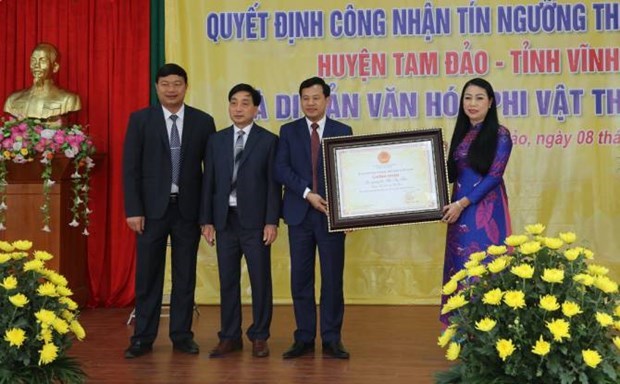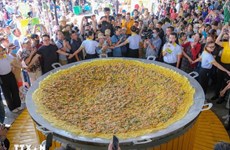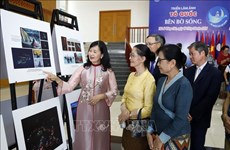Worship of Mother Goddess in Vinh Phuc recognised as intangible national cultural heritage
 Photo: Hoang Thi Thuy Lan, member of the Party Central Committee and Secretary of Vinh Phuc province’s Party Committee hands over the recognition decision to representatives of the Tam Dao district. (Source: vinhphuc.gov.vn)
Photo: Hoang Thi Thuy Lan, member of the Party Central Committee and Secretary of Vinh Phuc province’s Party Committee hands over the recognition decision to representatives of the Tam Dao district. (Source: vinhphuc.gov.vn)
Hanoi (VNA) – The worship of Tay Thien Mother Goddess in Tam Dao district, the northern province of Vinh Phuc, has been recognised as an intangible national cultural heritage.
The locality held a ceremony on March 8 to announce the recognition decision by the Ministry of Culture, Sports and Tourism.
Legend has it that under the reign of the seventh Hung King, in Dong Lo there was a rich man called Lang Vi. He was generous and handsome. His wife was Dao Thi Lieu – a beautiful, gentle, resourceful and benevolent woman. They were very rich but didn’t have a child, so they often visited holy sites to pray for one. One day they visited Thach Ban peak in the Tam Dao mountains and prayed for a child at a pagoda.
After their third prayer, Lieu had a dream. In it, she saw a mass of clouds in five colours covering the pagoda and releasing a scent. In the middle of the clouds appeared an eagle, then a group of beautiful fairies playing lutes, singing and dancing. Lieu suddenly woke up from the dream, believing it was a good omen. She then became pregnant, giving birth on the 10th day of the fifth lunar month of the Year of the Monkey, and named her child Lang Thi Tieu.
Tieu was a precocious talent when she was small. By the time she reached 20, she was known as an admirable heroine. Following an invasion, the Hung King ordered Lang Thi Tieu to recruit 3,000 soldiers. The king gave her more troops and horses and she defeated the enemy. Returning home in triumph, she was asked to enter the court, but refused the king’s request and asked for permission to return to her hometown to take care of her parents. The king agreed, conferring the title “Tam Dao Son Tru Quoc Mau” (Tam Dao National Mother) and allowed her to rule Dong Lo.
After her parents passed away, she went to the Tay Thien pagoda on Thach Ban peak to pray to Buddha. On the way home the next day, she felt tired and took a break. It suddenly went dark. From a mass of clouds of five colours an angel appeared and said, “The Heavenly Emperor ordered you to come back to Heaven, princess!” Then, she washed herself carefully and followed the angel, disappearing into the clouds. It was the 15th day of the second lunar month. After she returned to Heaven, people in Dong Lo and the surrounding areas built a temple to worship her.
Tay Thien festival is held annually from the 15th to the 17th day of the second lunar month to commemorate Mother Goddess Lang Thi Tieu. The site is located in Tam Dao district and was recognised as a special national historical relic site in December 2015.
Based on research works and the agreement of the National Heritage Council, on January 14, 2020, the Ministry of Culture, Sports and Tourism issued Decision No. 176 on announcing the list of national intangible cultural heritages, including The worship of Tay Thien Mother Goddess in Tam Dao district.
Along with the worship of the Hung Kings – the legendary founders of the nation, and Tan Vien Son Thanh – the God of Tan Vien Mountain, the worship of Tay Thien Mother Goddess is one of the three oldest rituals in the north.
In 1763, the dictionary of the Le Trung Hung Dynasty (1533-1789) clearly stated relic sites for worshipping the Tay Thien Mother Goddess. The worship is not only a belief of a locality and an area, but a national belief. At the same time, it is a cultural symbol of Vinh Phuc province and a heritage that has values of history, culture and patriotic tradition of ethnic groups.
Chairman of the Tam Dao district People’s Committee Dinh Van Muoi emphasised that the locality will continue to popularise and promote relevant images to domestic visitors and people, and international friends, and build specific plans to preserve and uphold the belief effectively./.













